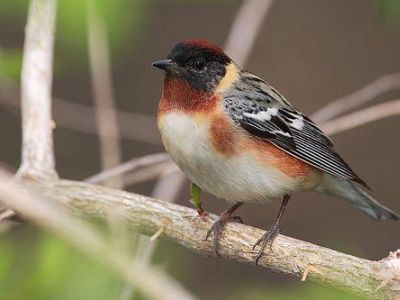B-BAYW-Bay-breasted Warbler

Bay-breasted Warbler
Setophaga castanea
- Phylum: Craniata
- Class: Aves
- Order: Passeriformes
- Family: Parulidae
The bay-breasted warbler (Setophaga castanea) is a small species of songbird in the New World warbler family, Parulidae. It is one of thirty-four species in the diverse genus Setophaga.
General Information
Key Habitat Features
Mature to old white spruce forests (80-140+ years), >5 ha.
Pure stands or mixed with aspen, birch and poplar located upland or adjacent to riparian reserves.
Nesting habitat: old spruce with dead lower branches, understory of high-bush cranberry, paper birch, dogwood or sitka alder.
Nesting and foraging habitat requirements are similar, nesting habitat also tied to presence of spruce budworm.
Objectives
Minimize disturbance during the breeding season.
Maintain nesting habitat throughout all seasons.
Maintain desired plant communities and key habitat features.
Planning and Operational Measures
All Activities
Identify key habitat features using appropriate measures (i.e. QP direction, desktop review, field confirmation, etc) and plan activities within the operating area accordingly.
Maintain unfragmented, mature pure or mixed spruce forest patches >5 ha within identified Bay-breasted Warbler habitat.
Avoid activity within riparian areas that consist of mature coniferous or mixed wood forest.
Avoid sensitive areas such as nest sites and foraging habitat.
Time works such that they occur outside of the critical timing window.
All Activities
Undertake construction and operation of oil and gas activities in a manner that minimizes impacts to desired plant communities and key habitat features.
Timing considerations when working within identified habitat:
Avoid disturbance and/or clearing activities during the critical timing window from May 1 to July 31.